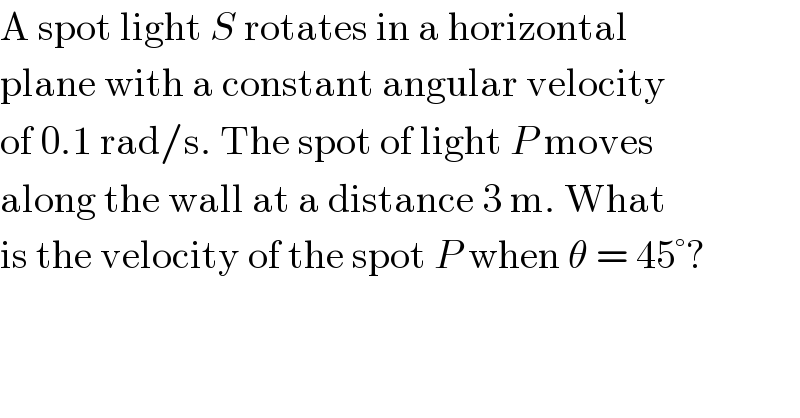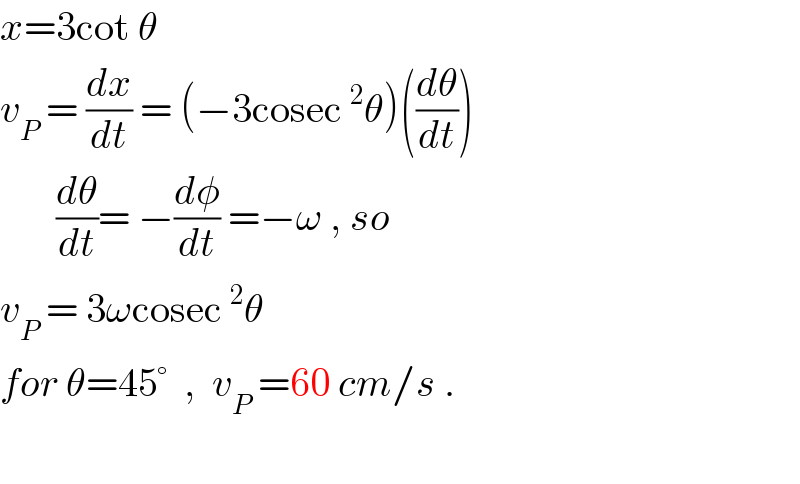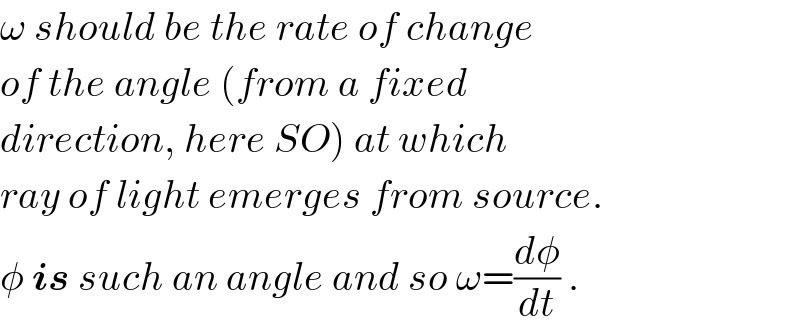
Question Number 24506 by Tinkutara last updated on 19/Nov/17

$$\mathrm{A}\:\mathrm{spot}\:\mathrm{light}\:{S}\:\mathrm{rotates}\:\mathrm{in}\:\mathrm{a}\:\mathrm{horizontal} \\ $$$$\mathrm{plane}\:\mathrm{with}\:\mathrm{a}\:\mathrm{constant}\:\mathrm{angular}\:\mathrm{velocity} \\ $$$$\mathrm{of}\:\mathrm{0}.\mathrm{1}\:\mathrm{rad}/\mathrm{s}.\:\mathrm{The}\:\mathrm{spot}\:\mathrm{of}\:\mathrm{light}\:{P}\:\mathrm{moves} \\ $$$$\mathrm{along}\:\mathrm{the}\:\mathrm{wall}\:\mathrm{at}\:\mathrm{a}\:\mathrm{distance}\:\mathrm{3}\:\mathrm{m}.\:\mathrm{What} \\ $$$$\mathrm{is}\:\mathrm{the}\:\mathrm{velocity}\:\mathrm{of}\:\mathrm{the}\:\mathrm{spot}\:{P}\:\mathrm{when}\:\theta\:=\:\mathrm{45}°? \\ $$
Commented by Tinkutara last updated on 19/Nov/17

Commented by ajfour last updated on 19/Nov/17

$${x}=\mathrm{3cot}\:\theta \\ $$$${v}_{{P}} \:=\:\frac{{dx}}{{dt}}\:=\:\left(−\mathrm{3cosec}\:^{\mathrm{2}} \theta\right)\left(\frac{{d}\theta}{{dt}}\right) \\ $$$$\:\:\:\:\:\:\:\frac{{d}\theta}{{dt}}=\:−\frac{{d}\phi}{{dt}}\:=−\omega\:,\:{so} \\ $$$${v}_{{P}} \:=\:\mathrm{3}\omega\mathrm{cosec}\:^{\mathrm{2}} \theta\: \\ $$$${for}\:\theta=\mathrm{45}°\:\:,\:\:{v}_{{P}} \:=\mathrm{60}\:{cm}/{s}\:. \\ $$$$\:\:\:\: \\ $$
Commented by Tinkutara last updated on 19/Nov/17

$${But}\:{why}\:\frac{{d}\phi}{{dt}}=\omega? \\ $$
Commented by ajfour last updated on 19/Nov/17

$$\omega\:{should}\:{be}\:{the}\:{rate}\:{of}\:{change} \\ $$$${of}\:{the}\:{angle}\:\left({from}\:{a}\:{fixed}\right. \\ $$$$\left.{direction},\:{here}\:{SO}\right)\:{at}\:{which} \\ $$$${ray}\:{of}\:{light}\:{emerges}\:{from}\:{source}. \\ $$$$\phi\:\boldsymbol{{is}}\:{such}\:{an}\:{angle}\:{and}\:{so}\:\omega=\frac{{d}\phi}{{dt}}\:. \\ $$
Commented by Tinkutara last updated on 19/Nov/17

$${But}\:{it}\:{says}\:{horizontal}\:{circle},\:{and}\:\frac{{d}\phi}{{dt}} \\ $$$${will}\:{be}\:{when}\:{vertical}\:{circle}. \\ $$
Commented by ajfour last updated on 19/Nov/17

$${the}\:{diagram}\:{is}\:{top}\:{view}\:{of}\:{the} \\ $$$${situation},\:{baseline}\:{of}\:{wall}\:{is} \\ $$$${shown},\:{dont}\:{assume}\:{it}\:{to}\:{be} \\ $$$${height}\:{of}\:{wall}\:.. \\ $$
Commented by Tinkutara last updated on 19/Nov/17

$$\mathrm{Thank}\:\mathrm{you}\:\mathrm{very}\:\mathrm{much}\:\mathrm{Sir}! \\ $$
Commented by ajfour last updated on 19/Nov/17

$$\theta+\phi\:=\:\frac{\pi}{\mathrm{2}} \\ $$$${d}\theta\:=−{d}\phi\: \\ $$
